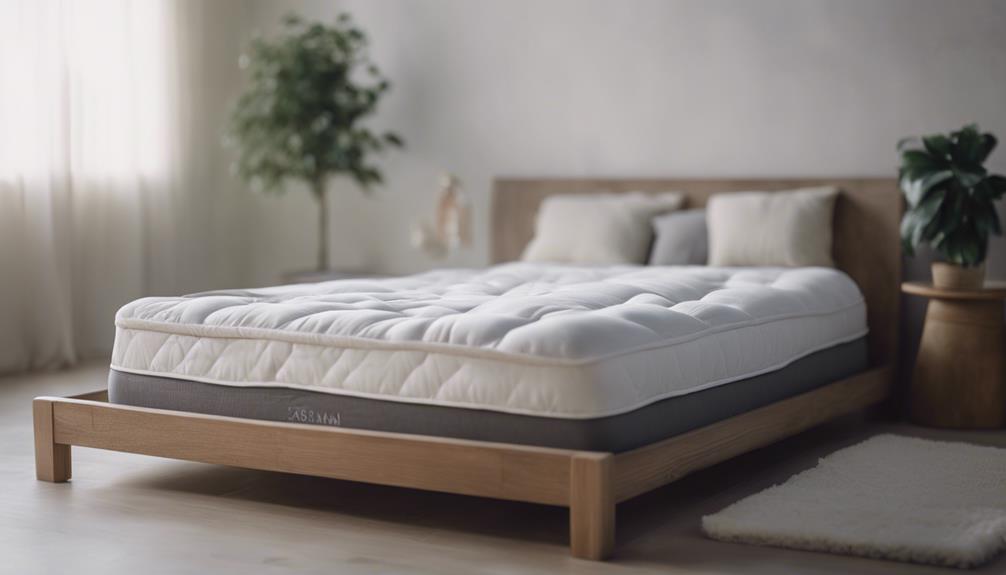Yes, you can wash a heated mattress pad! Just be sure to follow some precautions. First, unplug the controller and remove any electrical components. Then, carefully detach the electric cord and wires. Use a gentle cycle with cold water and mild detergent when washing. It’s crucial to wash the pad separately to safeguard its delicate wiring. After washing, air dry the pad completely to preserve its top condition. By following these steps, you can help extend the pad’s lifespan and performance. Interested in learning more tips for properly maintaining your heated mattress pad?
Key Takeaways
- Disconnect electrical parts before washing to avoid damage.
- Use a gentle cycle with cold water and mild detergent.
- Wash the pad separately to protect delicate wiring.
- Air dry thoroughly to maintain integrity.
- Regular cleaning enhances performance and longevity.
Precautions Before Washing a Heated Mattress Pad

Before washing a heated mattress pad, it's important to disconnect the controller and electrical parts to prevent any potential damage during the cleaning process. This step is vital to guarantee the safety of the pad and maintain its functionality.
When it comes to cleaning, using a gentle cycle with cold water in a front load washer is recommended for the best results. This method helps to prevent any unnecessary wear and tear on the pad while effectively removing dirt and stains. Additionally, dry cleaning the heated mattress pad is another suitable option for those who prefer not to wash it at home.
Removing Electric Cord and Wires

To guarantee safety and prevent damage, disconnecting the electric cord and wires from the heated mattress pad before washing is essential. Before tossing your heated mattress pad into the washing machine, it's important to remove the power cord carefully. This step is necessary to protect the wiring from potential water damage during the washing process.
By ensuring that all electrical components, including the power cord, are completely detached, you can avoid any hazards that may arise from moisture exposure. Follow the manufacturer's instructions meticulously to detach the electric cord from the mattress pad safely. Properly disconnecting the electric cord and wires isn't only required for maintaining the functionality of your heated mattress pad but also essential for ensuring the safety of the washing process.
Taking the time to remove the power cord correctly will help you keep your heated mattress pad in top condition for a cozy night's sleep.
Choosing the Right Detergent for Washing

When preparing to wash a heated mattress pad, selecting a mild detergent without bleach or fabric softeners is essential to avoid damaging the heating elements and maintain the pad's quality. Opt for a gentle detergent that is specifically designed for delicate fabrics to guarantee safe cleaning. Harsh chemicals can compromise the effectiveness and longevity of the heated mattress pad, so choosing the right detergent is important. Here is a handy guide to help you select the appropriate detergent for washing your heated mattress pad:
| Mild Detergent Options |
|---|
| Free & Clear |
| Woolite |
| Dreft |
| Seventh Generation |
| Babyganics |
These gentle detergents are suitable for cleaning sensitive fabrics and can help preserve the integrity of your heated mattress pad. By using a detergent that is mild and fabric-friendly, you can effectively clean your pad without risking any damage to the heating elements.
Washing the Heated Mattress Pad Separately

We recommend washing the heated mattress pad separately to prevent any potential damage. Washing it along with other bedding items can cause agitation and potential tearing due to the pad's delicate wiring. To guarantee the longevity of your mattress pad, it's vital to give it special care during washing. When cleaning the pad, opt for a gentle detergent that's suitable for delicate fabrics to avoid any harsh chemicals that could potentially damage the wiring. Following the manufacturer's instructions on the best way to clean the mattress pad is critical for maintaining its quality.
Separating the mattress pad from other items also allows for a more thorough and gentle cleaning process. This method prevents tangling with other fabrics and ensures that the pad receives proper care. After washing, make sure to air dry the mattress pad completely before reusing it. This step is crucial to prevent any moisture from getting trapped inside, which could lead to mold or mildew growth. By following these steps, you can keep your heated mattress pad in excellent condition for a long time.
Air Drying Techniques for the Pad

When drying a heated mattress pad, it's recommended to hang it on a clothesline or shower rod to prevent damage to the electrical components. Proper air drying techniques are essential for maintaining the longevity and effectiveness of these mattress pads.
Here are three tips for air drying your heated mattress pad effectively:
- Avoid using clothespins: When hanging your mattress pad to dry, refrain from using clothespins as they can potentially cause tears in the fabric. Opt for gently draping the pad over the clothesline or rod to guarantee even drying without risking damage.
- Ensure complete dryness: Before reconnecting the plugs and using the mattress pad again, make sure it's completely dry. Moisture can be damaging to the electrical components of the pad, so allowing it ample time to air dry is vital for safety and functionality.
- Regular maintenance: Incorporating proper air drying practices into your routine maintenance of the heated mattress pad can significantly prolong its lifespan and ensure consistent performance. By following these guidelines, you can help preserve your mattress pad for long-term use.
Avoiding the Use of a Dryer

To preserve the integrity of your heated mattress pad, it's best to refrain from using a dryer during the drying process. Air drying is the gentlest method to guarantee the safety of the heating system within the pad.
The dry heat from a dryer can potentially harm the internal components, leading to malfunctions or even permanent damage. Opting for a more natural drying process by hanging the pad to dry on a shower curtain rod is a great alternative.
This method helps maintain the pad's shape and size, preventing any shrinkage that could affect its fit on the mattress.
Tips for Maintaining Heating Elements

After ensuring that the heating elements are completely dry, it's important to use a gentle detergent and cold water when washing to maintain their integrity. When it comes to maintaining the heating elements in your heated mattress pad, there are a few essential tips to keep in mind:
- Avoid harsh chemicals: Harsh chemicals or bleach can cause damage to the internal wiring of the heating elements, leading to potential malfunctions. Stick to gentle detergents to guarantee longevity.
- Check for exposed wiring: Before washing your mattress pad, always check for any exposed or damaged wiring on the heating elements. This step is critical in preventing any electrical hazards or malfunctions.
- Regular inspections: Make it a habit to regularly inspect the heating elements for signs of wear and tear. By catching any issues early on, you can ensure safe and efficient operation of your heated mattress pad for a longer period.
Importance of Proper Drying for Longevity

Properly drying a heated mattress pad is essential for maximizing its longevity and ensuring safe usage. When it comes to mattress pads, taking the time to air dry them thoroughly can greatly extend their lifespan. Hanging the pad to dry instead of using a dryer is important to prevent any damage to the heating elements within the pad. One practical tip is to utilize a shower curtain rod for drying, as this guarantees the pad dries completely before storage.
It's important to avoid using a damp mattress pad, as moisture can lead to mold or mildew growth, ultimately reducing the longevity of the pad. Additionally, ensuring complete dryness before storage is key to maintaining the effectiveness of the heating elements. By following these proper drying techniques, you not only increase the longevity of your heated mattress pad but also ensure its continued safe and efficient performance.
Benefits of Regular Cleaning for Performance

Regular cleaning of a heated mattress pad enhances its performance by maintaining the effectiveness of the heating elements. Here are three key benefits of regular cleaning for the performance of mattress pads:
- Efficiency: Dust mites and allergens can accumulate over time, reducing the pad's ability to generate and distribute heat evenly. By routinely cleaning your heated mattress pad, you guarantee that it functions at its best, providing you with the warmth and comfort you need for a good night's sleep.
- Hygiene: A clean mattress pad promotes a healthier sleeping environment by preventing the buildup of bacteria and allergens. Regular cleaning not only extends the lifespan of the pad but also helps you maintain a hygienic space where you can rest peacefully without concerns about potential health issues.
- Longevity: Proper maintenance through regular cleaning not only improves the pad's immediate performance but also contributes to its overall longevity. By taking care of your mattress pad through consistent cleaning, you can enjoy its benefits for a more extended period, maximizing your investment in quality sleep.
Frequently Asked Questions
Can Heated Mattress Pads Go in the Dryer?
Yes, heated mattress pads should never be put in the dryer due to the risk of damaging the heating elements. Drying them this way can lead to overheating and electrical issues.
It's best to air dry them by using a clothesline or a flat surface. Following the manufacturer's instructions for drying methods is essential for ensuring the safety and durability of your heated mattress pad.
Can You Machine Wash a Heating Pad?
Absolutely, you can machine wash a heating pad! It's important to check the manufacturer's guidelines beforehand.
Remember to unplug the power cord first to prevent any mishaps. Opt for a gentle cycle, cold water, and mild detergent for best cleanliness. Skip the bleach and fabric softeners to maintain the pad's quality.
After washing, air dry or tumble dry on low heat to avoid any potential damage. Follow these steps for a clean and cozy heating pad all year round.
Can You Put a Mattress Pad in the Washer and Dryer?
Yes, you can put a mattress pad in the washer and dryer, but it's important to follow specific care instructions.
Always check the label for guidance on the appropriate washing and drying methods. Using a gentle cycle with cold water and avoiding bleach or fabric softeners is key to preserving the quality of your mattress pad.
After washing, make sure to air dry or tumble dry on a low heat setting for best results.
What Is the Life Expectancy of a Heated Mattress Pad?
The life expectancy of a heated mattress pad can vary from 5 to 10 years based on usage and care. Regular cleaning and proper maintenance can greatly extend its lifespan. Things like overheating, physical damage, and incorrect storage can reduce how long it lasts.
Conclusion
In summary, washing a heated mattress pad is an important step in maintaining its performance and longevity. By following the proper precautions and using the right detergent, you can guarantee that your pad stays clean and safe to use.
Remember to air dry the pad and avoid using a dryer to protect the heating elements. Regular cleaning won't only benefit your health but also enhance the overall comfort and efficiency of your heated mattress pad.
So, don't delay, start washing today for a cozy night's sleep!









